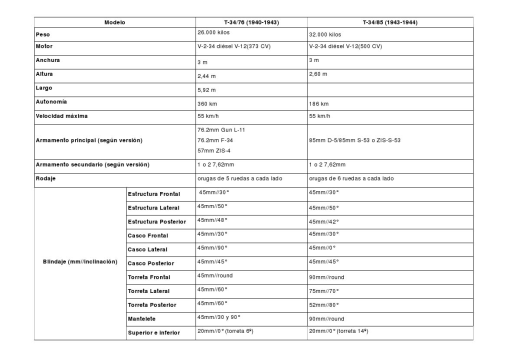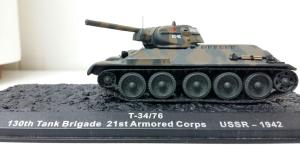In this issue, we will continue with the history of tanks. This time we will see the tank T-34 (1ªparte) a soviet tank produced between 1940 and 1945 (from 1940 to 1943 T-34/76 and 1943-1945 T-34/85).
The T-34 is the tank with better balance in firepower, mobility and protection existing at that time, although at the beginning it was not so. The unwillingness of the crew, lack of radio, bad ammunition and inadequate tactics ruin the expectations put on it.
At the end of 1943 with the entrace into action of T-34/85, with a higher power cannon, better design and manufacturing, constantly improved efficiency and cost reduction, allowed the Soviet Unión had a higher number of vehicles. In late 1945 this versatile tank just replaces most of light and heavy trucks in service in the Soviet Union

The T-34 is based on light tanks T-26 and BT but they had to revolutionize their designs after they realized the weaknesses revealed after its participation in the Spanish Civil War. In 1937, Mikhail Koshkin was appointed to the Red Army to lead the team responsible for developing the design of the new tank at the factory KhPZ Kharkov. The prototype was an A-20, but Koshkin convinced Stalin to make a second prototype designated A-32 and later renamed T-32.


Both models were tested in the border wars with Finland in the town of Kubinka in 1939 where the T-32 (A-32) exceeded by far the A-20. The cost of production and the reluctance of the Soviets to manufacture T-32 controls disappear completely when they saw the poor performance of these in Finland and the superiority of the German Blitzkrieg in France. Al these led them to the approval of manufacturing T-32 but a heavier version and better armored than 45 mm. T-34 is the designation given by the Soviet Union, the German designation was T-34/76, this version was used until late 1943 when there were improvements in this scene and appeared in the T-34/85.

Production
The beginning of the construction of the vehicle was full of major problems in the beginning and became a challenge for the Soviet Union. The different components of the vehicle were distributed by several manufacturing plants in the country. There were many problems: The armor plates were defective due to a shortage in the supply of new V2 engines was supplemented with others from light trucks BT, only the commander had a radio, the L-11 original barrel did not reach expectations, for which the design office started manufacturing the new F-34 gun 76.2 mm even without the approval of the Defense Committee although it was approved after the troops would praise its effectiveness in combat. Then political pressures came for massively manufacturing of T-34 (T-34M), but the surprise German attack in Operation Barbarossa and the urgent need to immediately send tanks into battle did not allow to start such production and they could only afford component modifications that were easyly and quickly manufactured. The rapid advance of the Germans into the Soviet Union forced it to a continuous relocation of factories producing components and assembling them to other places into the country. While this was going on, the Stalingrad tractor factory produced 40% of the T-34 that went into battle until the city was besieged in autumn 1942. with the emergence in combat of Tiger I and Panzer V Panther the need to improve the T-34 became a reality, but with the few existing units of German tanks until 1943 those improvemest were no taken seriously, which was a grave for Soviet crews who could hardly fight those tanks 76.2 mm cannons.
In 1942 construction of the new turret Project for the abandoned T-34M in started improving the limited space inside the previous turret, adding a cupola for the commander in full view, the wheels came to have the steel flange instead of the above rubber that were designed so that the tank could move even without tracks, and a new clutch for the 5-speed transmission and engine. Despite all these great improvements, when the T-34/76 faced heavy German tanks in the Battle of Kursk, the requests from the front line to have more firepower at long range made the Soviet leadership take the decision to immediately produce the new model turret but with a 85 mm cannon. With this enhancement turret T34 happens to have a capacity of three men, radio panel and the commander was able to leave the management of the canyon to the charger and gunner, and also have direct communication with the crew and the rest of the battalion, where he previously only had communication with the driver and communicated with the rest of the battalion through signs, for which must go outside in combat. Thus T-34/85 was born.
From 1944 the crew started using tungsten core ammunition (BR-365p) that could penetrate almost 40% more than the BR-365 missiles, but with less explosive power. IN COMBAT
IN COMBAT
T-34 was used as the symbol of the Soviet counterattack against the German invasion. The appearance of the T-34 in 1941 in the battlefield was a psychological blow to the invading German forces hoping to meet with an underequipped enemy. The T-34 could knock out the 1941 German tanks, but there were large and serious mechanical problems, especially clutch and transmission and more than half of the losses were for this reason and not by enemy fire. Finally these problems were solved.
During the winter of 1941-1942 they returned to have supremacy over the German tanks as they could move easily in the mud and snow due to its wide tracks where the heaviest German tanks would be stuck in the mud. German infantry was also exceeded because their guns 36 and 50 mm were ineffective. Yet the T-34 did not achieve greater success by rapid and poor training of their crews and leaders. In mid-1943 production was 1000 vehicles per month, but Soviet losses exceeded the German due to this ineffective instruction.
In the last years of the conflict, the Soviets increased their combat tactics and returned to have supremacy over the Germans. The appearance of T-34/85 in early 1944 gave the Red Army a vehicle with better armor and speed than Panzer IV and Stumgschütz III. Although their shield was still worse than Panther’s, firepower was greatly balanced. Panther’s frontal impenetrability at any distance began to be vulnerable below the 600 meters and 2000 meters using subcalibre ammunition.
 The great advantage existed in the number of units, much higher in the T-34, their better chassis and high mobility, for otherwise the Panther for a year had serious mechanical problems were most of their casualties. The T-34/85 was good enough, with an expert crew and in favorable situations, inclined the balance in their favor. The subcalibre ammunition allowed it to penetrate armor of 120 mm at 30 degrees at a distance of 500 meters, which set in troubles Tiger I and Panther’s rear and sides.
The great advantage existed in the number of units, much higher in the T-34, their better chassis and high mobility, for otherwise the Panther for a year had serious mechanical problems were most of their casualties. The T-34/85 was good enough, with an expert crew and in favorable situations, inclined the balance in their favor. The subcalibre ammunition allowed it to penetrate armor of 120 mm at 30 degrees at a distance of 500 meters, which set in troubles Tiger I and Panther’s rear and sides.
HISTORICAL FACT
In August 1944, Lieutenant Aleksander Oskin, was conducting a survey of Ogledow (Poland) population in command of his T-34/85 and a budget of infantry when they encountered a German company approaching their position. The German group was supported by Panzer grenadiers belonging to the 501 Battalion of heavy tanks. Oskin hid his car behind bushes and branches of a nearby grove. He was surprised by the way of the Germans advanced. They were not doing it properly, because they only sent three vechicles, without accompaniment, and in single file instead of expanding.
Oskin believed that these were three Panther manned by inexperienced men and decided that, with the advantage of surprise and camouflage, he would destroy them before retiring. But as soon as he lined them up he realized the mistake he had made having confused them: those were Tiger II. They had no information on how to deal with them. But the situation and their good position you were so favorable that he decieded to force his luck. He also had sufficient 365p BR shells, the shooting range was ideal, 200 mts, and the enemy was showing his flank and entering as a parade. Besides they were quite separated from their main force and would soon be able to receive help.
And Lady Luck smiled at him. The first shell hit the side of the turret of the second Tiger II (the one in the middle of the line) which burst with an explosion and knocking him out. The other two Tiger II were unable to locate his position, although they had their time, as the destroyed tank kept going and Oskin performed five more shots on goal. The other two Tiger, by chance, turned their turrets in the right direction. Oskin made 3 piercing projectile shots, but bounced off the front of the turret untill goddess Fortune reappeared and the fourth shot hit the turret’s ring popping one of the Tiger II. The third Tiger II, unable to locate shots, began the withdrawal but took a hit in the engine and was disabled. Oskin did not want to tempt Fortune any moreand retired without any casualties before the rest of the battalion came into position.
This is the end of the first part of this great tank. In the second one we will comment more details about this Soviet battle tank.
I hope you have enjoyed it
Author: Escipionelafricanus_ps, Pedro.
Translated by: ElCidCampeador2014- Wayne or Rafa



















Reblogueó esto en Tercios Españoles 2015 (TESRH, TESR1 y ELCID).
Me gustaMe gusta